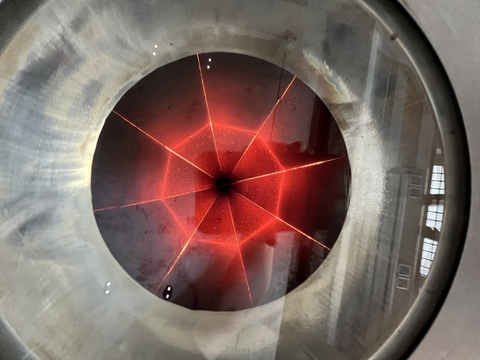Cemex and Synhelion make further progress toward the world’s first fully solar-powered cement plant

Close-up of Synhelion’s receiver delivering the high-temperature solar process heat beyond 1,500°C. (Photo: Business Wiire)
At the beginning of 2022, the companies announced the first-ever successful production of solar clinker in a small-scale batch process pilot. Advancing from that stage to production under plant-like and continuous conditions reaffirms the tremendous potential of this technology to reach industrial-scale implementation. Cemex and Synhelion will now take further steps toward building a solar-driven industrial-scale pilot cement plant.
“I am convinced we are getting closer to the technologies that will enable net-zero CO2 cement and concrete production,” said Fernando A. González, CEO of Cemex. “The solid progress I see here proves that solar cement is not just a dream; it is achievable through continued collaboration and backed up by rigorous research and testing.”
Gianluca Ambrosetti, Co-CEO and Co-Founder of Synhelion, added, “This is an exciting milestone for everyone involved, achieved through the excellent collaboration between the teams of Cemex and Synhelion. Our technology can make an important contribution toward decarbonizing cement production, and we look forward to more trailblazing achievements in this field.”
Clinker is produced in a rotary kiln at temperatures nearing 1,500°C. Fossil fuels are typically used to heat the kiln and are responsible for approximately
The partnership between Cemex and Synhelion has received important recognition recently. The
This project is part of Cemex’s Future in Action program, which focuses on achieving sustainable excellence through climate action, circularity, and natural resource management with the primary objective of becoming a net-zero CO₂ company by 2050. Two essential elements of this program are Cemex Ventures and Cemex’s R&D Center in
About Cemex
Cemex, S.A.B. de C.V. (“Cemex”) (NYSE: CX) is a global construction materials company that is building a better future through sustainable products and solutions. Cemex is committed to achieving carbon neutrality through relentless innovation and industry-leading research and development. Cemex is at the forefront of the circular economy in the construction value chain and is pioneering ways to increase the use of waste and residues as alternative raw materials and fuels in its operations with the help of new technologies. Cemex offers cement, ready-mix concrete, aggregates, and urbanization solutions in growing markets around the world, powered by a multinational workforce focused on providing a superior customer experience enabled by digital technologies. For more information, please visit: www.cemex.com
About Synhelion
Synhelion is a global pioneer in the field of carbon-neutral solar fuels. The clean energy company evolved from the Swiss Federal Institute of Technology (ETH Zurich) in 2016 to decarbonize the transportation sector. Synhelion is currently building the world’s first industrial facility for the production of solar fuel in Jülich,
View source version on businesswire.com: https://www.businesswire.com/news/home/20230803401989/en/
Cemex
Analyst and Investor Relations -
Fabián Orta
+52 (81) 8888-4327
ir@cemex.com
Analyst and Investor Relations -
Scott Pollak
+1 (212) 317-6011
ir@cemex.com
Media Relations
Jorge Pérez
+52 (81) 8259-6666
jorgeluis.perez@cemex.com
Synhelion
Media Relations
Carmen Murer, Head Corporate Communication
+41 79 619 52 11
carmen.murer@synhelion.com
Source: Cemex, S.A.B. de C.V.






